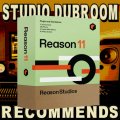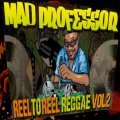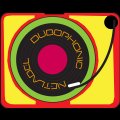|
We are now at the point where we have a full
instrumental track. But we're not quite
there yet. We have to take our 128 measures
of music and change things. The created full
riddim is rather boring without any drum
breaks and other variations and that's what
we're gonna work on a little bit in the
following chapters.
Right now, let's focus on the drums as
this is the reason why we want to start our
raw instrumental Reggae riddim at the ninth
bar. About 95% of all Reggae tracks start of
with a drum roll. You could say that this is
the "Reggae way" of counting off
before a track. Where others tick the drum
sticks or simply say "one, two three
four", in Reggae this is done by means
of a drum roll. There are many non-musical
reasons to think of why this is done but
let's not go there in this tutorial. Let's
just take it as a musical fact to consider.
Go to the eight bar of your drum track,
make it so that you will be able to create
16th notes and make the following
introduction roll:

EXAMPLE0019.MP3
Another thing in Reggae Music is that the
first eight bars often function as an intro
part. This is where horns play their theme
or singers introduce the track with one or
more vocal hooks. Very often, the first
eight bars end with a drum roll that starts
the sixth or seventh bar. As we will keep it
a bit simple, we'll just make a short break
at the eight bar. In the sequencer,this is
the 16th bar as we start of with 7 bars of
silence and a one-bar intro roll.
Go to the 16th bar and create this break
(click image to enlarge):

EXAMPLE0020.MP3
The start of your rhythm should now sound
something like this:
EXAMPLE0021.MP3.
Actually, you will recognize the Reggae
standard of the intro roll and the break in
the eight bar of the actual musical
track. We've now reached a point
wherein freedom can be enjoyed to the
fullness when it comes to the drums. At
least, freedom in responsibility.
Most tracks will have two or three breaks
after the introduction part, or even more.
Breaks can last sometimes up to four bars
but you will have to know exactly what you
do when you go there. More short and simple
breaks will do for now, as you don't need
this tutorial at this stage when you know
how to make a four bar break.
Sure, when you know exactly what you
want, or perhaps you have lyrics for which
you need a riddim. In these cases it is
quite important to place your breaks
strategically. You do not want a break in
the middle of a verse unless you deliberately
want such a thing, for example.
There's more you don't really want unless
you really do.
Take the beginner's mistake of putting
too many breaks in the rhythm. A break
should signify an important part like the
end of a chorus or verse, or it should just
do what the word says: give the riddim a
break. When you hear a break every let's say
16 bars, the break becomes part of the
rhythm and you'll end up creating a new
style, call it breakbeat and become
famous... But wait.... that has been done a
long time ago already so just don't do it.
Limit yourself to two or three breaks next
to the introduction parts. So let's say no
more than 5 in total during the whole
instrumental track. You do not want your
Hi Hat pattern to continue during a break,
either. A real drummer would never be able
to do this and so you should avoid such
unnatural things like the plague. Only do
such things when you know what rules you are
breaking and why you are breaking them. The
human brain simply does not accept such
things, even when it's just on a
subconscious level. You can alter your hi
hat pattern like in the example of this
chapter, though. End it with an open HiHat
hit that sounds during the break, fine. But
always keep in mind a drummer usually has
two arms and hands, not three or four. Now,
the best way in a situation like the one we
created now is to go with your feeling. One
way of determining the place of the breaks,
especially when your intention is to make
Dub primarily, is to simply let the drum and
the bass play without the piano. Press play
and listen intensly. You hear the
introduction roll and the first eight bars
that end with a break. Now listen, feel the
drum and bass line and there will be a point
wherein you will want to do something with
the drums. Let's do something with the
drums. Let's put the shortest breaks of all
somewhere: a simple crash on the thirn with
nothing else during the rest of the bar. You
will recognize this thing, especially in
live concerts. It shows the power of taking
things away, which -after all- is the
strength of Dub as well. Go to bar 40 in
your sequencer and do this with the drums:

EXAMPLE0022.MP3
Yes, you simply change the HiHat his on
the third count into a crash cymbal hit and
delete everything afterward in the bar. By
doing so, you effectively created a 24-bar
part in which you can do a thing and end it
at bar 40 in your sequencer. This can also
be a thing you will in your Dub mixing at a
later stage. Now, let's continue our drum
alteration session. Instead of putting a
break or crash cymbal,you can also slightly
change the drum pattern intself. We're going
to do that in the 64th bar in the sequencer.
Simply move the snare to the fourth count
and remove the hihats after the open hit at
the rird count. See below:

EXAMPLE0023.MP3
Now, let's get a bit more serious now as
we will put our first break in the actual
riddim. The first break after the
introduction parts. We'll do it in the 78th
bar where we simply change the Hi Hat hit on
the third count into a crash cymbal hit and
we'll put an open HiHat hit at the first
count of bar 79, after which there will be
no more HiHat in bars 79 and 80. Create
the following break in bars 79 and 80:

EXAMPLE0024.MP3
As you can see, we are over half of the
actual track and we have just put the first
break in there. But before we'll put another
one somewhere, let's take the variation we
made in the 64th bar of the sequencer and
paste it into bar 96 as well. A simple
crash hit at the third count of a bar can
mark the end of a part. A crash hit at the
very first count of a bar can signify the
sart of a part and we will do that as well
before will put our final break in the
riddim. We'll do it in bar 113 of the
sequencer..

EXAMPLE0025.MP3
Since most parts of the riddim we're
making has 24 bars, this crash hit signifies
the start of the last 24 bars of the riddim.
Our last break will be to end the riddim
itself. Go to bar 137 and make the following
break:

EXAMPLE0026.MP3
Voila! You've created your first full
Drum line!
|
































